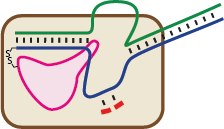Crosslinking of Promoter DNA to T7 RNA Polymerase Does Not Prevent Formation of a Stable Elongation Complex
Edward A. Esposito and Craig T. Martin, J. Biol. Chem.279, 44270-44276, 2004

T7 RNA polymerase recognizes a small promoter, binds DNA, and begins the process of transcription by synthesizing short RNA products without releasing promoter contacts. To determine whether the promoter contact must be released to make longer RNA products and at what position the promoter must be released, a mutant RNA polymerase was designed that allows cross-linking to a modified promoter via a covalent disulfide bond. The modifications individually have no measurable effect on transcription. Under oxidizing conditions that produce the protein-DNA cross-link, the complex is able to synthesize short RNA products, strongly supporting a model in which promoter contacts are not lost on translocation through at least position +6. However, cross-linked complexes are impaired in promoter escape in that only about one in four can escape to make full-length RNA. The remainder release 12- and 13-mer RNA transcripts, suggesting an increased energetic barrier in the transition from an initial transcribing complex to a fully competent elongation complex. The results are discussed in the context of a model in which promoter release helps drive initial collapse of the upstream edge of the bubble, which, in turn, drives initial displacement of the 5′-end of the RNA.
PMID: 15304497 DOI: 10.1074/jbc.m407688200